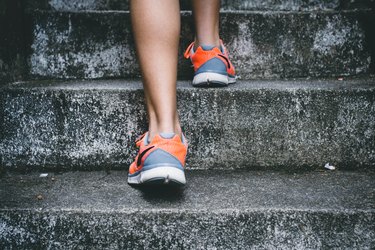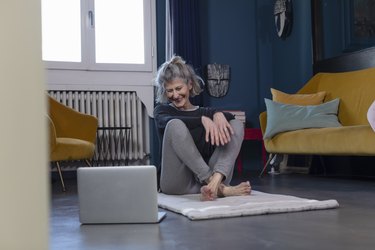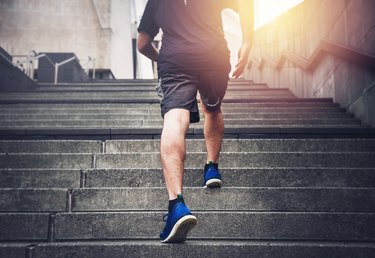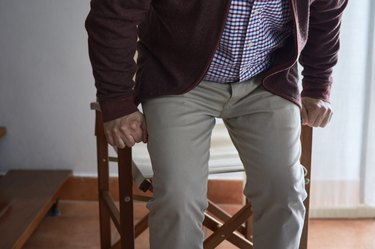

One of the most underrated benefits of strength training is how it helps you do mundane, daily activities. Seemingly simple tasks, like climbing a flight of stairs, actually require a lot of muscular strength, mobility, coordination and balance.
If you feel unsteady climbing stairs, or even experience pain or discomfort trying to tackle a flight, then there are a few things you can do in your workouts to make climbing stairs easier.
Video of the Day
We're not talking anything too intense or complex. In fact, some simple body-weight exercises can help build the strength in your lower-body muscles — and the mobility in your and knee joints — that you need to climb up and back down a staircase without trouble or pain. Balance is also important here.
"Because stair climbing is essentially performed one leg at a time, it means each leg has to be strong enough to lift our whole body's weight multiple times per staircase," Megan-Marie Delegas, DPT, a physical therapist and founder of Megan-Marie PT, tells LIVESTRONG.com. "Single-leg activities require us to coordinate shifting," she adds, which is where balance factors in.
Every part of your lower body is involved in climbing stairs — the big muscles like the quadriceps, hamstrings and glutes, which power most of the movement, plus the muscles in your ankles and toes, which are essential when you push off each foot.
The exercises below strengthen and increase mobility in all of these areas. Plus, they'll challenge your balance in a safe way so that you feel steady and ready to tackle any set of stairs that comes your way.
Move 1: Air Squat
The air squat is a foundational movement in any exercise program, Delegas says. "It targets every muscle of the lower body in a way that can simultaneously improve the range of motion of each major joint, like the hips, knees and ankles."
- Stand with your feet between hip- and shoulder-width apart and your toes facing forward or outward slightly.
- Keeping your feet flat on the floor and your back straight, brace your core and push your hips back and down until your thighs are parallel to the ground, or as low as you can comfortably go while still maintaining a flat back.
- Pause here for a brief moment, and then drive through your heels to stand back up.
Modifications
If you have a hard time getting low enough or feel pressure in the front of your knees, place a chair behind you and sit lightly on it with each rep. This can help train the right hip hinge pattern that puts more of the work into your glutes.
If your heels feel the urge to lift off the floor, make the squat more shallow. Or, you can place a 1-inch pad or block under your heels to help you hit the right depth despite any ankle mobility issues, Delegas says.
Move 2: Split Squat With Hold
"Split squats place our feet in a split-stance position, which mimics walking and puts more emphasis on individual leg strength," Delegas says. In a split stance position, the toes are both extended and working on stabilizing us, which mimics the push-off that happens during stair climbing and descending, Delegas says.
It also challenges balance and coordination but isn't as difficult or high-impact as a lunge or other exercise where you fully lift one foot off the ground and have to land. The main focus here is strengthening the muscles in the glutes and legs.
- Stand with your feet about hip-width apart, and then take a big step forward with one foot to get into a split stance. Place your hands on your hips. Pull your shoulder blades back and down, brace your core and keep your torso nice and tall.
- Bend both knees and let the heel of your back foot rise up. Lower as far as comfortable or until your back knee almost touches the floor and your front thigh is parallel with the floor.
- Hold at the bottom for 3 to 5 seconds.
- Press through your front foot to raise up without moving your feet.
Modifications
If you feel off-balance, widen your feet to hip width or slightly farther, or hold onto a countertop or chair for support.
Move 3: Military Squat
Compared to the split squat, the military squat is done with a slightly wider stance that will let you sink deeper and tap further into hip mobility, Delegas says. The goal is to lower down until your back knee is actually on the ground.
"The positioning of this exercise puts a lot of simultaneous emphasis on range of motion, such that your toes, ankles, knees, and hips will be challenged," she says.
- Stand with your feet together, and then step one foot forward so that you are in a narrow split-stance position with your front foot flat on the floor and back foot on your toes and your hands on your hips. Pull your shoulder blades back and down, brace your core and keep your torso nice and tall.
- Bend both knees and let the heel of your back foot rise up. Lower until your back knee touches the floor. If you need to, adjust your stance by stepping a little wider so that you can hit this full range.
- Press through your front foot to raise up without moving your feet.
Modifications
“The goal is to get all the way to the floor with control,” Delegas says. “If you can’t, which is common, then only go as low as you feel stable and comfortable.” Over time and as you get stronger, you’ll likely find you can get lower.
If you feel off-balance, widen your feet to hip width or slightly farther, or hold onto a countertop or chair for support.
Move 4: Single-Leg Glute Bridge
The single-leg bridge trains the hip-hinge movement and strengthens the muscles surrounding the hips.
"To ascend stairs well, we really need a robust hip system," Delegas says. "Hinge exercises like the glute bridge are excellent for targeting this area of the body."
- Lie on your back with your arms at your sides, feet flat on the ground and knees bent.
- Raise your left foot off the ground and bring your knee toward your chest. Grab onto the back of the leg just above the knee and hold throughout the movement. Keep this knee bent.
- Press into your right heel and raise your hips up, contracting your glutes.
- Reverse the motion and bring the hips back to the ground.
Modifications
If lifting with one leg is too challenging, keep both feet planted on the floor.
Move 5: Standing Single-Leg Calf Raise
"Heel [aka calf] raises are an underutilized strength exercise that most of the population would benefit from," Delegas says. "In the context of stair climbing, we need to be able to powerfully push off our toes every time we take a step up. Calf raises support that exact movement."
- Stand near a wall with your hands on the wall for support.
- Lift one leg off the floor and bend the knee. Engage your core to hold the leg here throughout the movement.
- Rise up on the ball of your standing foot as high as you can go. Think about moving vertically, not rocking forward.
- Lower back down to the ground.
Modifications
If it’s too difficult to do this single-leg exercise 10 times, do the heel raises on both feet at the same time instead.
Move 6: A-Run
"It's one thing to climb stairs, and it's another to ascend with a little bounce and rhythm," Delegas says. "A-runs are an excellent way to build and maintain elasticity in the tendons, and power through the muscles. Having this gives you that bounding ability you see when people skip steps or run up stairs like they're floating."
Bonus: Your heart rate is definitely going to rise with this one.
- Stand tall, arms by your sides.
- Start running place, but keep the motion small so that your toe just barely come off the floor before touching it again. Pump your arms as you "run."
- When you're ready to work up to it, lift the legs a little higher as you run. Eventually, your knees should come to about hip-height with each stride.
Modifications
The video shows three options for how high to lift your knees. Pick what feels most comfortable for you, depending how experienced you are, Delegas says.
“Start easier by picking a lower level height, or a cadence you feel comfortable with, then build both over 4 to 8 weeks.”


